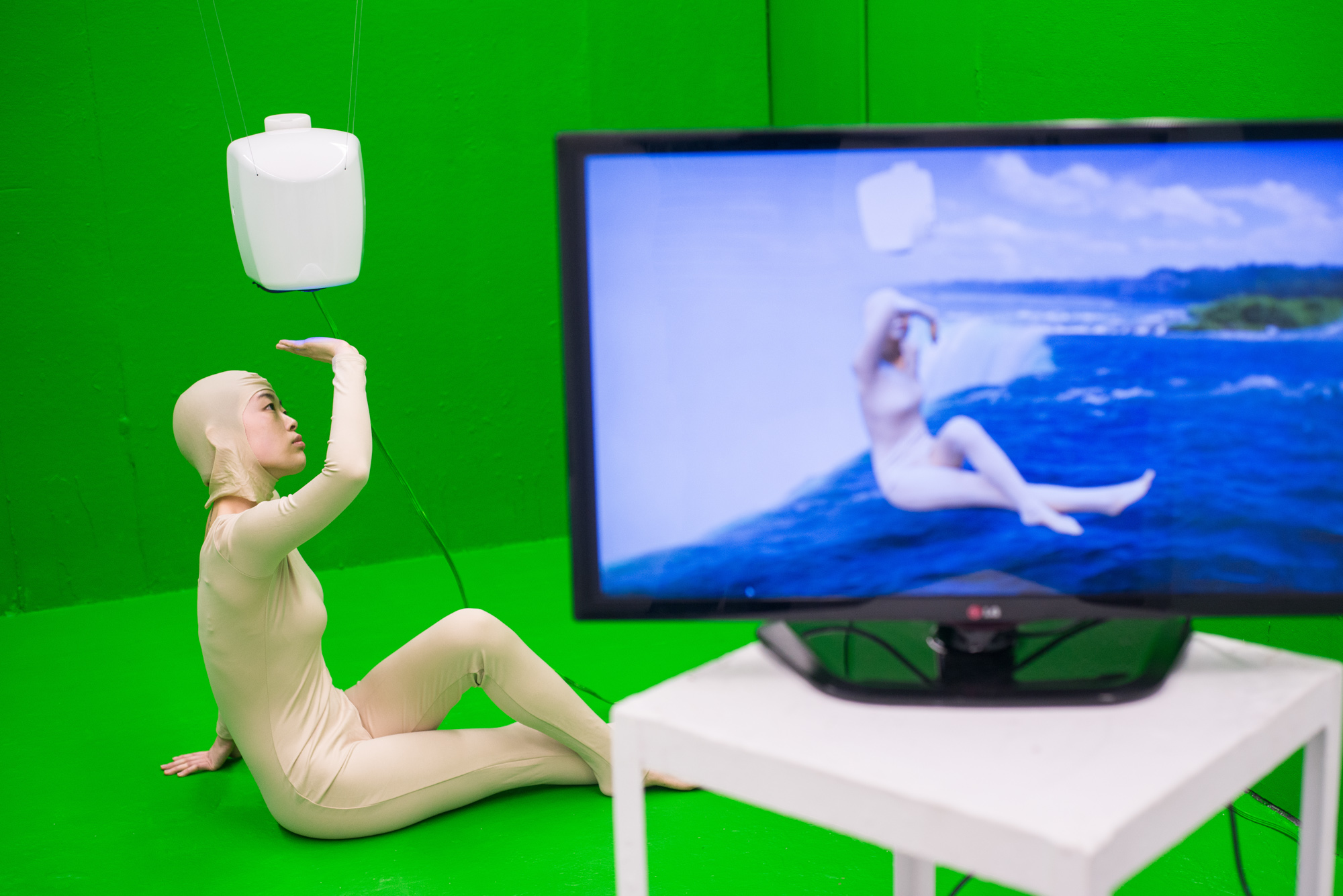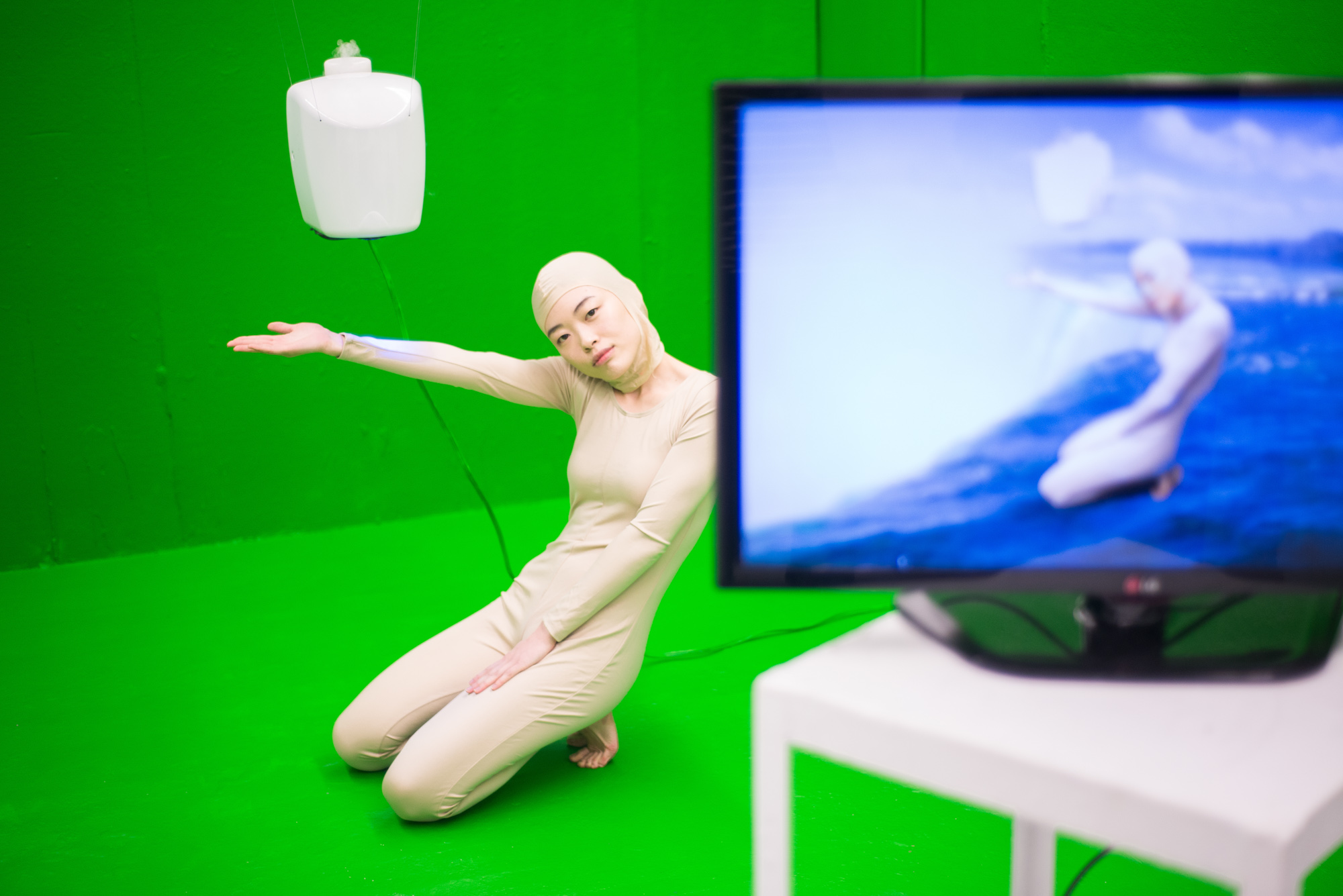ingridzhuang.com

"Channel Jerky," 2016, performance, 3 hours (Zhuang_Image1)
Law prohibits human species with any fluid content to be in public spaces, except under specific supervisions. Any human species that is not in its “jerky-form” is subject to inspection. For detailed instructions on the extraction procedure, please check Channel Jerky.
The human species came to the solution to extract water and any kinds of body fluid from the adult corpse and store them elsewhere in order to preserve the last bit of water resources, as it is essential to the reproductive system and also brain development. Humans therefore, have adopted a different kind of body structure—a flat sheet of dried flesh (resembling what is commonly known as the beef jerky). They also have the option of rolling up their bodies for easy transportation. Water and body fluids are permitted to replenish back into the human bodies only under two conditions: when knowledge needs to be circulated for the development of their brains (which means in schools, children and adults would be soaked up in water, and rehydrate their brains for the intake of knowledge), and when they need fluids for reproduction.

"Channel Jerky," 2016, performance, 3 hours (Zhuang_ Image2)

"Channel Jerky," 2016, performance, 3 hours (Zhuang_Image3)
"Natural Tasting," 2015-16, video, 5 minutes 5 seconds (Zhuang_Video4)
Natural Tasting (2015-16) is a five-minute video installation, running in a loop. The concept of body is key in guiding the process of metamorphosis in the linear narrative, from fish to broccoli, then from human flesh to roasted chicken and to piglets. In this fictive biological evolution, human being is merely part of a larger system of relations, consuming as well as being consumed, abstracting yet already being abstracted. Occupying multiple flat screens of various dimensions on the wall, the visually dynamic video installation creates an absurd fantastical world surrounding the viewers. As the moving images travel from one screen to the next and compete for the viewer’s attention, they aim to create an overwhelming feeling of mediation, in which images multiply and nest within or on top of one another. There is an element of violence present, suggesting that notions of familial attachment and utopian longings are ultimately fictions produced through a variety of ongoing contradictions, aka capitalism. Making reference to contemporary American sensibility—the trending pursuit of an organic lifestyle, Natural Tasting employs visual effects of propaganda while establishing a fictional narrative pointing at issues generated by the deceptive marketing strategies and systems under conditions of permanent crisis."
Do or Die, May 15, 2015 from Ingrid Zhuang on Vimeo.
"Do or Die," 2015, performance, 8 minutes 13 seconds (Zhuang_Video5)
Do or Die (2015) is a second iteration of the performance Savior (2015), adopting a game structure similar to that of the “musical chairs”. Both works see the body as a primary site for contestation, and as an environment that encompasses and extends beyond the human form. The linked silver bodies is not only a physical and social stricture the performers must negotiate with, but also a symbolic vehicle for circulation, communication and exchange among the performers and the audience. The ubiquity of cell-phones as cameras was another way in which the sci-fi mise-en-scene of the game was collapsed with the real world. And then the whole performance devoured itself. Again the question of collectivity emerged as a touchstone, how many bodies can become a whole, incomplete and inconsistent, yet still a group, because they are all tied together, coming apart."
"Savior," 2015, performance, 6 minutes 12 seconds (Zhuang_Video6)
Human senses are deeply social in character. There is little of “human nature” that is outside relationship, outside culture. Yet, there seem to be some psychological states that are simply there, beyond interpretation. And surely the most compelling of these is pain. Pain initially contains an extreme privacy of the occurrence that is invisible to anyone outside the boundaries of the person’s body. However, when it merges into the realm of imagining, they begin to move out of the self-contained loop within the body and become sharable. As the sentience of pain enters into a process of externalization, it becomes “social and acquires its distinctly human form.” In other words for pain to be communicable, what was first conceived as anterior to language and so inseparable from the body, eventually has to go through an image of agency and be projected onto an object, which then becomes something concrete that must enter the social realm. "
"Studio," 2014, performance documented on 9-channel surveillance system, 4 hours (Zhuang_Video7)
Studio (2014) is a four-hour durational performance, excavating inherent inequalities within existing social structures, exploring the (re)construction of identity based on personal and communal experiences, and challenging the fluid boundaries of dependency and relationship formation. The interstitial relationships formed between cultures, as well as those formed in the public and private spheres. Physically connecting the performers with lycra (stretchy fabric made into body suits/costumes), Zhuang creates a temporary community (a kind of micro-society) where each performer is restricted by the material structure of the outfit, but also free to some extent within each studio space to do his or her own work. Employing tropes of the surveillance system, Zhuang hopes the viewers (of the video documentation) could encounter the performance from an anthropological perspective—trying to make sense of the world the performers were in; the kind of “human” activity, and “human” nature. "
Ingrid Zhuang’s artistic practice is rooted in her research of the posthuman theories, particularly the Object-Oriented Ontology. Through the lens of fictional narrative and humor, her work engages in conversations around utopian longings for and speculations of what the future will look like, and the potential of a dystopic tomorrow. Working across media including writing, drawing, installation, performance and video, Zhuang has explored concepts of collectivity, nature and nurture, the social structure of ideal and imaginary communities, and most recently she has re-imagined a different kind of biological evolution in a multi-channel video installation.
Ingrid Zhuang (b. 1989) is a performance and video artist living and working in New York. Born and raised in Beijing, Zhuang moved to the U.S. in 2004. She received her Bachelor of Art degree in Art History and Bachelor of Science degree in Economics from Duke University in 2013. In 2016, Zhuang will graduate from The New School’s MFA of Fine Arts program. Her work has been exhibited at The New School; XY Atelier Art Gallery in New York; Industry City in Brooklyn; Ne’na Contemporary Art Space in Chiang Mai, Thailand; Riverworks Gallery in Greenville, SC, among others.
Ingrid Zhuang (b. 1989) is a performance and video artist living and working in New York. Born and raised in Beijing, Zhuang moved to the U.S. in 2004. She received her MFA of Fine Arts in 2016 from The New School, a Bachelor of Art degree in Art History and a Bachelor of Science degree in Economics from Duke University in 2013. Her work has been exhibited at The New School; XY Atelier Art Gallery in New York; Industry City in Brooklyn; Ne’na Contemporary Art Space in Chiang Mai, Thailand; Riverworks Gallery in Greenville, SC, among others.


